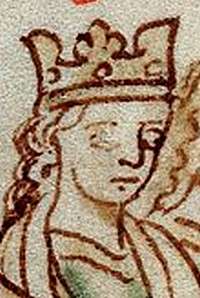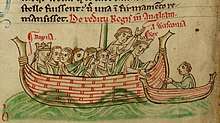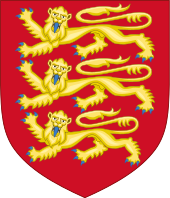Eleanor of Provence
Eleanor of Provence (c. 1223 – 24/25 June 1291[1]) was a French noblewoman who became Queen consort of England as the wife of King Henry III from 1236 until his death in 1272. She served as regent of England during the absence of her spouse in 1253.[2]
| Eleanor of Provence | |
|---|---|
 | |
| Queen consort of England | |
| Tenure | 14 January 1236 – 16 November 1272 |
| Coronation | 20 January 1236 |
| Born | c. 1223 Aix-en-Provence, France |
| Died | 24/25 June 1291 Amesbury, Wiltshire, England |
| Burial | |
| Spouse | Henry III, King of England |
| Issue | Edward I, King of England Margaret, Queen of Scots Beatrice of England Edmund, Earl of Lancaster Katherine of England |
| House | Barcelona |
| Father | Ramon Berenguer IV, Count of Provence |
| Mother | Beatrice of Savoy |
| Religion | Roman Catholicism |
Although she was completely devoted to her husband, and staunchly defended him against the rebel Simon de Montfort, 6th Earl of Leicester, she was very much hated by the Londoners. This was because she had brought many relatives with her to England in her retinue; these were known as "the Savoyards", and they were given influential positions in the government and realm. On one occasion, Eleanor's barge was attacked by angry Londoners who pelted her with stones, mud, pieces of paving, rotten eggs and vegetables.
Eleanor had nine children, including the future King Edward I of England. She also was renowned for her cleverness, skill at writing poetry, and as a leader of fashion.
Early life
Born in the city of Aix-en-Provence in southern France, she was the second daughter of Ramon Berenguer IV, Count of Provence (1198–1245) and Beatrice of Savoy (1198–1267), the daughter of Thomas I of Savoy and his wife Margaret of Geneva. She was well educated as a child, and developed a strong love of reading. Her three sisters also married kings.[3] After her elder sister Margaret married Louis IX of France, their uncle William corresponded with Henry III of England to persuade him to marry Eleanor. Henry sought a dowry of up to twenty thousand silver marks to help offset the dowry he had just paid for his sister Isabella, but Eleanor's father was able to negotiate this down to no dowry, just a promise to leave her ten thousand when he died.
Like her mother, grandmother, and sisters, Eleanor was renowned for her beauty. She was a dark-haired brunette with fine eyes.[4] Piers Langtoft speaks of her as "The erle's daughter, the fairest may of life".[5] On 22 June 1235, Eleanor was betrothed to King Henry III (1207–1272).[1] Eleanor was probably born latest in 1223; Matthew Paris describes her as being "jamque duodennem" (already twelve) when she arrived in the Kingdom of England for her marriage.
Queen

Eleanor was married to King Henry III of England on 14 January 1236.[6] She had never seen him prior to the wedding at Canterbury Cathedral and had never set foot in his kingdom.[7] Edmund Rich, Archbishop of Canterbury, officiated. She was dressed in a shimmering golden dress that fitted tightly at the waist and flared out to wide pleats at her feet. The sleeves were long and lined with ermine.[8] After riding to London the same day where a procession of citizens greeted the bridal pair, Eleanor was crowned queen consort of England in a ceremony at Westminster Abbey which was followed by a magnificent banquet with the entire nobility in full attendance.[9] Her love for her husband grew significantly from 1236 onward.
Unpopularity
Eleanor was a loyal and faithful consort to Henry, but she brought in her retinue a large number of uncles and cousins, "the Savoyards", and her influence with the King and her unpopularity with the English barons created friction during Henry's reign.[10] Her uncle William of Savoy became a close advisor of her husband, displacing and displeasing English barons.[11]
Though Eleanor and Henry supported different factions at times, she was made regent of England when her husband left for Gascony in 1253. Eleanor was devoted to her husband's cause, stoutly contested Simon de Montfort, raising troops in France for Henry's cause.
On 13 July 1263, she was sailing down the Thames when her barge was attacked by citizens of London.[12] Eleanor stoutly hated the Londoners, who returned her hatred; in revenge for their dislike Eleanor had demanded from the city all the back payments due on the monetary tribute known as queen-gold, by which she received a tenth of all fines which came to the Crown. In addition to the queen-gold other such fines were levied on the citizens by the Queen on the thinnest of pretexts.[13] In fear for her life as she was pelted with stones, loose pieces of paving, dried mud, rotten eggs and vegetables, Eleanor was rescued by Thomas Fitzthomas, the Mayor of London, and took refuge at the bishop of London's home.
Queen dowager
In 1272 Henry died, and her son Edward, who was 33 years old, became king of England. She remained in England as queen dowager, and raised several of her grandchildren—Edward's son Henry and daughter Eleanor, and Beatrice's son John. When her grandson Henry died in her care in 1274, Eleanor went into mourning and gave orders for his heart to be buried at the priory at Guildford which she founded in his memory. In January 1275 she expelled the Jews from all of her lands.[14] Eleanor's two remaining daughters died in 1275, Margaret on 26 February and Beatrice on 24 March.
She retired to a convent; however, she remained in contact with her son, King Edward, and her sister, Queen Margaret of France.
Eleanor died on 24/25 June 1291 in Amesbury, eight miles north of Salisbury, England. She was buried in Amesbury Abbey. The exact site of her grave at the abbey is unknown making her the only English queen without a marked grave. Her heart was taken to London where it was buried at the Franciscan priory of Greyfriars.[15]
Cultural legacy
Eleanor was renowned for her learning, cleverness, and skill at writing poetry,[7] as well as her beauty; she was also known as a leader of fashion, continually importing clothes from France.[5] She often wore parti-coloured cottes (a type of tunic), gold or silver girdles into which a dagger was casually thrust, she favoured red silk damask, and decorations of gilt quatrefoil, and to cover her dark hair she wore jaunty pillbox caps. Eleanor introduced a new type of wimple to England, which was high, "into which the head receded until the face seemed like a flower in an enveloping spathe".[5]
She had developed a love for the songs of the troubadors as a child, and continued this interest. She bought many romantic and historical books, covering stories from ancient times to contemporary romances written in the period (13th century).
Eleanor is the protagonist of The Queen From Provence, a historical romance by British novelist Jean Plaidy which was published in 1979. Eleanor is a main character in the novel Four Sisters, All Queens by author Sherry Jones, as well as the novels The Sister Queens by Sophie Perinot, and "My Fair Lady: A Story of Henry III's Lost Queen" by J. P. Reedman. She is also the subject of Norwegian Symphonic metal band Leave's Eyes in their song "Eleonore De Provence" from their album Symphonies of the Night.
Issue
Eleanor and Henry had five children together. Eleanor seems to have been especially devoted to her eldest son, Edward; when he was deathly ill in 1246, she stayed with him at the abbey at Beaulieu in Hampshire for three weeks, long past the time allowed by monastic rules.[16] It was because of her influence that King Henry granted the duchy of Gascony to Edward in 1249. Her second youngest child, Katherine, seems to have had a degenerative disease that rendered her deaf. When the little girl died at the age of three, both her royal parents suffered overwhelming grief.[17] Eleanor possibly had four other sons who also died in childhood, but their existence is in doubt as there is no contemporary record of them.[lower-alpha 1]
- Edward I (1239–1307), married Eleanor of Castile (1241–1290) in 1254, by whom he had issue, including his heir[18] Edward II. His second wife was Margaret of France, by whom he had issue.[18]
- Margaret (1240–1275), married King Alexander III of Scotland, by whom she had issue.[18]
- Beatrice (1242–1275), married John II, Duke of Brittany, by whom she had issue.[18]
- Edmund Crouchback, 1st Earl of Lancaster (1245–1296), married Aveline de Forz in 1269, who died four years later without issue; married Blanche of Artois in 1276, by whom he had issue.
- Katherine (25 November 1253 – 3 May 1257)[18]
Notes
| Wikimedia Commons has media related to Eleanor of Provence. |
- Until the late 20th century, historians also accepted the existence of four other children, Richard (d. 29 August 1250), John (b. 1250 – d. 31 August 1252), William (d. c. 1256) and Henry (b. May 1260 – d. 10 October 1260).[18] Subsequent historical analysis has shown that it is improbable that these children existed, and historians such as Huw Ridgeway and Margaret Howell conclude that Henry and Eleanor had only five children.[19] These five – Edward, Margaret, Beatrice, Edmund and Katherine – are well documented in multiple chronicler and financial accounts from Henry's reign.[20] The only record for Richard, John, William and Henry is in the Flores Historiarum manuscript, but the details appear to have been added to the original 13th document in the next century, albeit possibly in good faith.[21] It is impossible to completely rule out the possibility that the children existed but that the other evidence of their existence was suppressed, perhaps because they were handicapped, or they were miscarriages or still births.[22]
References
- Charles Cawley, Medieval Lands, Provence
- Strickland, Agnes. Lives of the Queens of England: From the Norman Conquest
- Cox 1974, p. 463.
- Costain 1959, pp. 125–126.
- Costain 1959, p. 140.
- Sadler 2008, p. 32.
- Costain 1959, p. 127.
- Costain 1959, p. 129.
- Costain 1959, pp. 129–130.
- Costain 1959, pp. 130–140.
- Cox 1974, p. 50.
- Costain 1959, pp. 253–254.
- Costain 1959, pp. 206–207.
- Alison Taylor, "Cambridge, the hidden history", (Tempus: 1999) ISBN 0752414364, p82
- Howell 2004.
- Costain 1959, p. 142.
- Costain 1959, p. 167.
- Howell 1992, p. 57
- Howell 2001, p. 45; Ridgeway, Huw W. (2004), "Henry III (1207–1272)", Oxford Dictionary of National Biography, online edition, Oxford University Press (published September 2010), doi:10.1093/ref:odnb/12950, archived from the original on 21 September 2013, retrieved 17 August 2013
- Howell 1992, pp. 58, 65
- Howell 1992, pp. 59–60
- Howell 1992, pp. 70–72; Howell 2001, p. 45
- Bibliography
- Costain, Thomas B. (1959). The Magnificent Century. Garden City, New York: Doubleday and Company.CS1 maint: ref=harv (link)
- Cox, Eugene L. (1974). The Eagles of Savoy. Princeton: Princeton University Press. ISBN 0691052166.CS1 maint: ref=harv (link)
- Howell, Margaret (1992). "The Children of King Henry III and Eleanor of Provence". In Coss, Peter R.; Lloyd, Simon D. (eds.). Thirteenth Century England: Proceedings of the Newcastle upon Tyne Conference, 1991. 4. Woodbridge, UK: Boydell Press. pp. 57–72. ISBN 0-85115-325-9.CS1 maint: ref=harv (link)
- Howell, Margaret (1997). Eleanor of Provence: Queenship in Thirteenth-century England.CS1 maint: ref=harv (link)
- Howell, Margaret (2004), "Eleanor (Eleanor of Provence) (c.1223–1291), queen of England", Oxford Dictionary of National Biography, Oxford: Oxford University Press, retrieved 14 December 2010
- Sadler, John (2008). The Second Barons' War: Simon de Montfort and the Battles of Lewes and Evesham. Casemate Publishers. ISBN 978-1-84415-831-7.CS1 maint: ref=harv (link)
- Cawley, Charles, Medieval Lands Project on Eleonore Berenger of Provence, Medieval Lands database, Foundation for Medieval Genealogy,
- The Peerage: Eleanor of Provence:
Eleanor of Provence Cadet branch of the Bellonids Born: c. 1223 Died: 24/25 June 1291 | ||
| English royalty | ||
|---|---|---|
| Vacant Title last held by Isabella of Angoulême |
Queen consort of England 14 January 1236 – 16 November 1272 |
Vacant Title next held by Eleanor of Castile |
